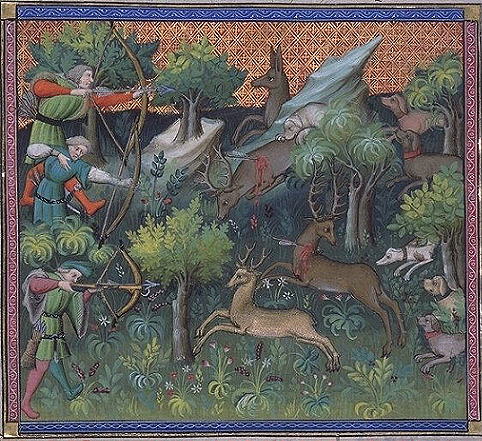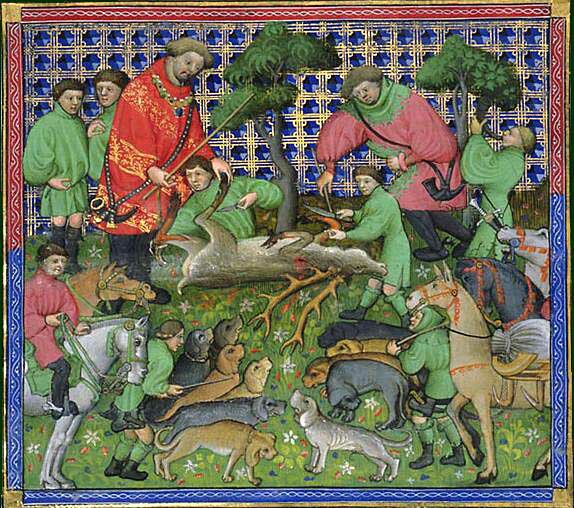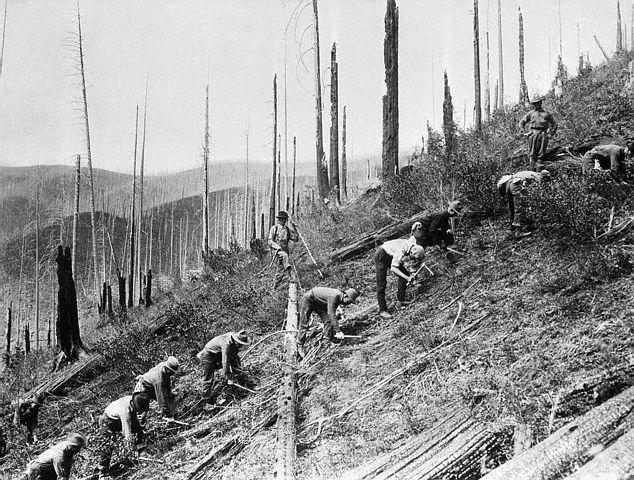 .
.Humans have spent most of their time on earth hunting, and it is not entirely surprising that there is at least some archaeological evidence of the activity.
In North American before Columbus, there were no metal tools or horses. Hunting was done entirely on foot, and hides and meat were hauled off by humans and dogs pulling travois skids.
In some rare locations a very efficient form of hunting was accomplished by running bison herds off of cliffs or "Buffalo Jumps" -- a fact we know today only because of the enormous piles of bison bones at the base of these cliffs, and the related stone tools and campfires.
Archaeologists have discovered that drive lines were made to direct herds of bison to the jumps. The drive lines consisted of rows of rock piles known as "dead men," arranged like a wide funnel that started up to 8 miles away from the jump site. The funnel gradually narrowed toward the jump end. Hunters hiding behind the "dead men" rock piles would spring out and wave robes and shout in order to frighten the animals and keep them inside the funnel and headed in a stampede towards the jump where they would tumble down, breaking legs and necks as they fell.
In Europe, large Deer Parks were created during the Middle Ages as a way of setting off land for aristocratic hunters and managing sustainable game populations for food. The edges of these parks were often edged by massive earthwork moats and mounds which, in turn, were topped by wooden fences. The moats were on the inside and prevented the deer from getting a foothold or a run-up to the top of the mound which was constructed from the earth taken from the moat excavation. Many UK locations with "Park" in their name are, in fact, old Deer Parks and with careful observation in some locations, you can see parts of remnant ditches and mounds.
As with the ancient Buffalo Jumps, hunting in deer parks was accomplished by driving game through funnel fences to archers who were positioned on the ground or in tree stands.
In the 14th Century there were over 3,000 deer parks in England occupying around 650,000 acres of land. These deer parks were managed for wild game and for wood. In the larger deer parks streams were dammed to make small lakes and ponds for fishing and ice making.
Most of the large deer parks fell into disrepair in late Medieval times as the feudal system collapsed under the weight of the Plague, and a new form of hunting -- coursing with horses and dogs -- was imported from France.
Another archaeological remnant of hunting to be found in Europe are rabbit warrens. The rabbit is not naive to the UK -- it was introduced (probably from Spain) by the Romans shortly after the First Century AD. Across the UK ancient artificial warrens can be found to this day. These warrens are called "pillow mounds" or buries and are flat topped, 10 to 20 metres long, 5 to 10 metres wide, and up to a metre high, sometimes surrounded by a shallow ditch. About 2,000 of these ancient buries survive in England, and in some of them artificial runs are covered with stone slabs. Some of the very largest artificial warrens had professional staff (a warrener) and buildings.
*
 .
.Duck and Fish Ponds provide additional archaeological evidence of hunting and angling across the globe. Many of these ponds have artificial islands on them created as spots where ducks and geese can breed free of predators. While the waters of these ponds were stocked with fish, the ponds were often designed with "dog-leg" lagoons, or a narrows on one end, where ducks and geese could be driven and easily netted.
The United States is a very young nation, and much of the Western U.S. was nearly devoid of people only 150 years ago. That said, Americans are industrious and the construction of small ponds and large lakes for water storage and ice-making naturally led to increased still-water angling and duck hunting.
In short order, some people began construction of dams specifically to increase angling and hunting opportunities. One such dam was constructed on the South Fork River near Johnstown, Pennsylvania. The dam itself was a massive earthen affair constructed by the South Fork Fishing and Hunting Club which counted among its 66 wealthy Pittsburgh residents Andrew Carnegie, Henry Clay Frick, Andrew W. Mellon, and Philander Knox.
At the time of its construction, the South Fork Dam was one of the largest in the world, but it was not well constructed. A flawed design was made worse when the Fishing and Hunting Club put screens across the safety spillway to prevent fish from washing over the dam during heavy rains. The spillway screens were constantly clogged with debris, but despite many warnings about the safety of the dam, the rich aristocrats who owned the hunting club continued on, business as usual.
On May 31, 1889, after a period of heavy rain, the dam finally gave way sending a 45-foot-tall wall of muddy water racing down the Conemaugh Valley. More than 2,209 lives were lost and 27,000 people were made homeless -- one of the greatest single losses of human life in the history of the United States.

Civilian Conservation Corps Tree Planters, 1939
The most notable period of U.S. construction for wildlife benefits began with the advent of the Civilian Conservation Corps (CCC) in 1936. The CCC was created as a Depression-era jobs program which eventually put millions of young men to work on reforestation, soil erosion, flood prevention, and trail construction projects across the United States..
The Corps was badly needed -- America had ruined scores of millions of acres of once-forested lands during the rip-rape-and-ruin robber baron era that lasted from 1850-1900.
Massive tracts of forest in our eastern mountains had been swept clean of trees, and streams were choked with silt. Wildlife had been shot out to the point that deer were nearly extinct, all beaver were gone, and ducks and geese were a rarity in areas where they had once been in dense numbers.
The Lacey act of 1907 and the Weeks Act of 1911 were important for protecting wildlife and conserving land, but wild America had been so severely hammered by unrestrained greed that it was to clear that it would take millions of hours of human labor and a lot of time to begin to set things right.
President Franklin Delano Roosevelt started the ball rolling in 1934 with the appointment of Committee on Wild-Life Restoration whose mandate was to prepare a plan to restore America's dwindling wildlife populations. Among its members were the great wildlife manager Aldo Leopold, and cartoonist Ding Darling.
The Wild-Life Committee recommended far-reaching changes to improve habitat for waterfowl, upland game, mammals, and song birds, including the acquisition of millions of acres of additional sub-marginal lands for habitat improvement, and appropriations of $50 million to restore these lands to some semblance of their natural self.
It did not take a genius to see that the Wildlife Restoration Plan and the Civilian Conservation Corps were ideal partners, and under the tutelage of Darling -- a man who later went on to create the Federal Duck Stamp Program and found the National Wildlife Federation -- significant gains were made in record time.
By the end of 1942, national wildlife refuges, national forests, and other public lands across the U.S. had been improved by CCC workers who constructed dams, dikes and fish hatcheries, planted millions of trees to stabilize stream banks and cover over ruined land, and erected numerous buildings, fire towers, telephone lines and support facilities for camping grounds, and improved backcountry-access for hunters and hikers.
Civilian Conservation Corps construction projects remain a significant addition to our National Parks, National Forests and Wildlife Refuge System to this day, and are too-little heralded part of our American wildlife heritage.
.
No comments:
Post a Comment